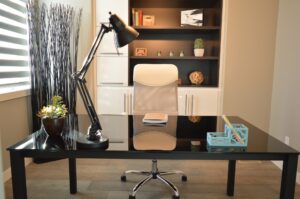 If you work at home and don’t have a comfortable home office or have one that’s not ideal, now is the time to convert a rarely used space (formal living and dining rooms), remodel a bedroom, or add a new addition. Costs are rising: labor, materials, equipment, furnishings, etc. Materials delivery is lagging too, but the sooner you start the sooner you’ll finish and possibly with a lower price tag. Financing is still at a relatively low rate, but interest rates are expected to rise by mid-year or sooner.
If you work at home and don’t have a comfortable home office or have one that’s not ideal, now is the time to convert a rarely used space (formal living and dining rooms), remodel a bedroom, or add a new addition. Costs are rising: labor, materials, equipment, furnishings, etc. Materials delivery is lagging too, but the sooner you start the sooner you’ll finish and possibly with a lower price tag. Financing is still at a relatively low rate, but interest rates are expected to rise by mid-year or sooner.
After a year-plus of being asked to work at home temporarily, you’re probably like many of us beginning to wonder if this might be the new normal. Some companies are also beginning to reconsider how much physical office space “togetherness” is really necessary to meet their business objectives. Those sprawling corporate campuses and skyscrapers are expensive. Many office employees also prefer some mix of home and company office time.
Tip 1: Location, Location, Location
 If you prefer to or have no other option and have to work at home, choose a home office location that’s off the beaten track. You want to be away from the flow of daily activity, especially when the kids are home. That means stay away from the kitchen, the family room (TV noise and the temptation to sneak in one more episode of your favorite binge-worthy streamer), hang-out, gaming, or play spaces such as upstairs landings and basements. Keeping these distractions to a minimum will increase your productivity all day long and help you keep your mind focused on the important stuff.
If you prefer to or have no other option and have to work at home, choose a home office location that’s off the beaten track. You want to be away from the flow of daily activity, especially when the kids are home. That means stay away from the kitchen, the family room (TV noise and the temptation to sneak in one more episode of your favorite binge-worthy streamer), hang-out, gaming, or play spaces such as upstairs landings and basements. Keeping these distractions to a minimum will increase your productivity all day long and help you keep your mind focused on the important stuff.
Tip 2: Lighting (Natural and Electric)
 Natural light is extremely important when it comes to creativity, mental health and attitude. If you’ve ever worked for any period of time in a secure building or interior office bay with no windows, then you understand. If you’re adding a room, first consider the east side of your home where there is morning sunlight because it’s warmer sooner in winter and cooler in summer. No matter where your home office is located, you’ll likely want to add more lighting and consider a dimmer for better control.
Natural light is extremely important when it comes to creativity, mental health and attitude. If you’ve ever worked for any period of time in a secure building or interior office bay with no windows, then you understand. If you’re adding a room, first consider the east side of your home where there is morning sunlight because it’s warmer sooner in winter and cooler in summer. No matter where your home office is located, you’ll likely want to add more lighting and consider a dimmer for better control.
Tip 3: Electric Power Outlets
 Most home bedrooms are designed with minimal power outlets and overhead lighting. You’ll need ceiling can lights to add more lighting throughout the room and more electrical outlets for a laptop and accessories, mobile phone charger, printer, larger monitors for eye comfort and maybe a WIFI modem booster. Whether converting or adding on, you might also need a new electrical panel to power up. There’s nothing more irritating than a breaker that constantly flips and safety is an issue too.
Most home bedrooms are designed with minimal power outlets and overhead lighting. You’ll need ceiling can lights to add more lighting throughout the room and more electrical outlets for a laptop and accessories, mobile phone charger, printer, larger monitors for eye comfort and maybe a WIFI modem booster. Whether converting or adding on, you might also need a new electrical panel to power up. There’s nothing more irritating than a breaker that constantly flips and safety is an issue too.
Tip 4: HVAC Comfort All Year
The location of your converted or new home office and the number of windows also affects your heating, ventilation and air conditioning (HVAC) efficiency. A bedroom office conversion where you’ll work all day might require additional ducting and vents. Home office additions will often need a new larger capacity HVAC system or standalone room system. This can be a power issue too when adding capacity.
Tip 5: Furnishings & Storage
Give yourself the gift of space and extra storage when possible. Most office cubicles include a computer station with printer and a separate basic work space with phone, as well as a file drawer, storage cabinet and book shelves. When converting a bedroom into an office or building a new home office, you’ll need room for all this equipment with room to walk around. An ergonomic desk chair is a must. Make it comfortable and you’ll get more work done.
Conclusions
If your current home office is problematic or if you’re considering adding on a new home office, we can help at Helfrich Associates. We’re licensed structural engineers with practical design-build experience including local permitting through the inspection phases of new construction. We’ll help you find the best solutions to working at home in a comfortable, productive space that is designed for your unique needs.
